Jacobs Aircraft Engines
by Kimble D. McCutcheon and Robert Brown
Published 6 Apr 2013; Revised 19 Nov 2019

Jacobs L-4 (R-755) |
Fischer & Jacobs was organized in Philadelphia, Pennsylvania on 1 Jan 1926, and constructed an experimental air-cooled 4-cylinder, 2-stroke radial intended to replace Curtiss OX-5s. Although the engine reportedly weighed less than 250 lb, and produced equivalent power, it was never produced.
Renamed Aircraft Engine Corporation, the company moved to Camden, New Jersey for a short time, and finally settled in Pottstown, Pennsylvania when it acquired a plant from the Light Machine and Foundry Company during its 1931 liquidation. The Pennsylvania Secretary of State Corporation Registry indicates that the Jacobs Aircraft Engine Company was incorporated on 31 Aug 1932. |
Albert R. Jacobs
Albert R. Jacobs, born in Philadelphia in 1894, developed an early interest in the Wright Brothers work on aircraft. He attended Girard College in Philadelphia, where he graduated with high honors, obtaining an engineering degree. He designed and built race car motors and learned to fly, receiving U.S. flying license No. 4 from Orville Wright. Jacobs' combined engineering skills and flying interest led to the design of his first Jacobs aircraft engine, which formed the basis of the Camden, New Jersey plant.
Early Engines
The first Jacobs engine, the Model LA-1, was a 7-cylinder air-cooled radial with a bore of 4.500" and a stroke of 4.750" that displaced 528.8 in³. Weighing 390 lb, it produced 140 hp at 1,800 rpm. The LA-1 received Approved Type Certificate No. 31 on 7 Feb 1929. Power was increased to 170 hp at 2,125 rpm in mid-1931, and about 60 were manufactured before the Type Certificate expired on 1 Dec 1935.
The LA-2, an enlarged version of the LA-1 with a 4.750" bore, displaced 589.2 in³. It weighed 400 lb and produced 195 hp at 2,075 rpm. This engine was awarded Approved Type Certificate No. 82 on 6 May 1932, which expired on 1 Dec 1935.
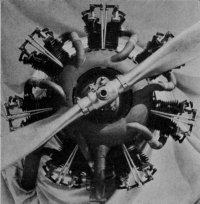 |
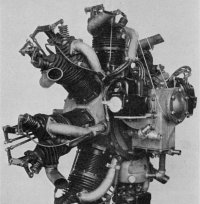 |
| Jacobs LA-1 |
Jacobs LA-1 |
Jacobs briefly experimented with, but never produced, a Model B-1. This air-cooled 2-cylinder 2-stroke, with a bore of 3.000" and a stroke of 2.500", displaced 35 in³, weighed 60 lb, and produced 20 ~ 25 hp at 2,500 ~ 3,000 rpm.
 |
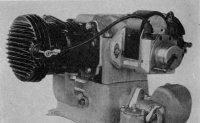 |
| Jacobs B-1 |
Jacobs B-1 |
The Jacobs Model L-3, which received Approved Type Certificate No. 75 on 12 Aug 1931, produced 51 hp at 2,125 rpm and weighed 189 lb. With a bore of 4.125" and a stroke of 4.750", the 3-cylinder L-3 displaced 190.4 in³. The Jacobs L-3, could be operated in either tractor or pusher configuration. Two flange-mounted Scintilla magnetos provided dual ignition, and a Stromberg NAS-3 carburetor furnished the mixture. Approximately 44 L-3s were built before the Type Certificate expired on 23 Jul 1941.
 |
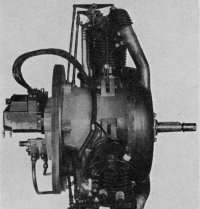 |
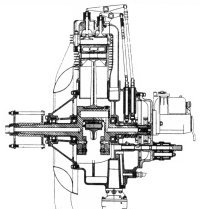 |
 |
| Jacobs L-3 |
Jacobs L-3 |
Jacobs L-3 |
Jacobs L-3 |
Classic Jacobs Engines
The Jacobs Model L-4 (Military R-755) , which received Approved Type Certificate No. 121 on 27 Feb 1934, incorporated many features of earlier Jacobs engines. It was the predecessor of R-755-series military engines that were built in profusion during WWII to power numerous training and light transport aircraft. Displacing 754.8 in³, the L-4 had a 5.250" bore, 5.000" stroke, and a 5.375:1 compression ratio. The L-4 had a takeoff rating of 245 hp at 2,200 rpm, normal rating of 225 hp at 2,000 rpm, and a cruise rating of 177 hp at 1,900 rpm on 73 octane gasoline. Its takeoff rating grew to 350 hp at 2,500 rpm in the postwar R-755E.
Model L-4 cylinder heads, with integral rocker boxes, were heat-treated aluminum alloy castings into which forged steel cylinder barrels were screwed and shrunk. Intake valves were of stainless steel and exhaust valves were of chrome-nickel steel with sodium-filled hollow stems. Aluminum bronze was used for valve seats. Valves were actuated by a cam ring with three intake and three exhaust lobes that ran at 1/6 crankshaft speed.
The two-piece crankshaft captured a one-piece master rod with six articulated rod. The crankshaft, master rod, and wrist pins were of alloy steel, but the articulated rods were aluminum alloy forgings machined to final dimensions by diamond boring, eliminating the need for bushings.
Forged aluminum alloy pistons had two compression and one oil ring above the wrist pin bore, and an oil ring below the pin. Full-floating wrist pins were positioned by aluminum end plugs.
Six main parts comprised the original crankcase design. A magnesium front case housed the cam mechanism and supported the propeller thrust bearing. An aluminum alloy diaphragm supported the front crankshaft main bearing. An aluminum alloy barrel type crankcase provided mounting pads for cylinders, a bearing diaphragm for the rear main crankshaft bearing. An aluminum alloy rear section contained a ring-type inlet manifold. An aluminum alloy intermediate rear bearing plate fed lubricating oil to the crankshaft and supported auxiliary drive gears. A magnesium accessory case provided mounting pads for ignition, generator, starter, oil pump, and tachometer.
By 1936 the crankcase had been redsigned so the power section was split through the cylinder plane. The new crankcase assembly consisted of five castings - front case, front main crankcase, rear main crankcase, rear intermediate bearing plate, and rear case. The two main crankcase sections, or the power section, are secure together by through-bolts and studs, and the other case sections are secured to these by an ample number of specially heat-treated studs. .All joints are heavily flanged.
The front case, cast from a magnesium alloy (later aluminum alloy), carried the cam gear and pinion assembly, tappet assemblies, propeller oil transfer ring assembly, thrust bearing and thrust plate.
The front main crankcase section was an aluminum alloy casting that carried the front main crankshaft roller bearing.
The rear main crankcase section was an aluminum alloy casting in which the intake manifold and oil sump were integrally cast; it carried the rear main crankshaft roller bearing and the carburetor. .
The rear intermediate bearing plate was a magnesium alloy (later aluminum alloy) casting and carried the rear crankshaft ball bearing and accessory drive gear bushing.
The rear case was cast from a magnesium alloy (later aluminum alloy) and provided mounting pads for ignition units, generator, starter. oil pump, fuel pump, and additional accessory drive units.
Dual ignition typically consisted of both a battery/distributor and magneto. A Stromberg NA-B7A carburetor was provided.
During WWII the L-4 was constantly improved and these improvements incorporated into older engnes as thay were overhauled.
 |
 |
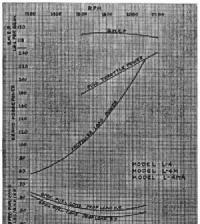 |
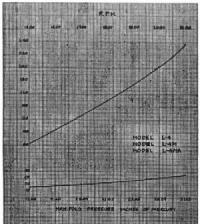 |
| Jacobs L-4 |
Jacobs L-4 |
L-4 Prop Load Curves |
L-4 Power Curves |
Jacobs L-4 through WWII
| Designation |
L-41 |
L-4M1 |
L-4MA1,2
(R-755-1) |
L-4MA72
(R-755-3) |
L-4MB
(R-755-9) |
L-4MT1
(R-755-5) |
L-4PT3
(R-755-7) |
| Ignition |
2 Distributors |
2 Magnetos |
2 Magnetos |
2 Magnetos |
1 Distributor
1 Magneto |
2 Distributors |
2 Magnetos |
| Length (inches) |
38.875 |
40.375 |
35.22 |
40.375 |
40.375 |
39.89 |
39.89 |
| Diameter (inches) |
43.500 |
43.500 |
43.500 |
43.500 |
43.500 |
43.500 |
43.500 |
| Basic Dry Weight (lb) |
4804; ± 3 |
473 ± 3 |
476 |
476 ± 3 |
4944 ± 3 |
476 |
520 |
| Notes: 1Old-style crankcase; 2Autogyro drive gears; 3Redesigned to AN Standards; 4Includes generator and control box |
The Model L-5 (Military R-830), an enlarged version of the L-4 displacing of 831.5 in³, received Approved Type Certificate No. 121 on 30 Jan 1936. Its bore was increased to 5.500" and its compression ratio to 6.00:1. The L-5 had both takeoff and normal ratings of 285 hp at 2,000 rpm.
L-5 Curves
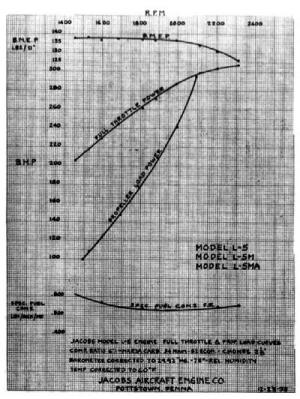 |
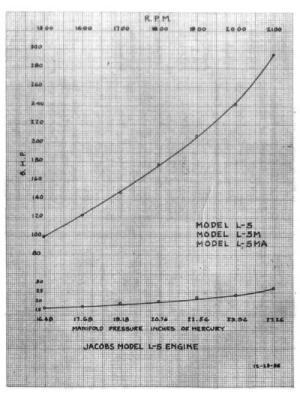 |
| Jacobs L-5 Prop Load Curves |
Jacobs L-5 Power Curves |
Jacobs L-5 Specifications
| Designation |
L-5 |
L-5M |
L-5MB |
L-5MA7 |
| Ignition |
2 Distributors |
2 Magnetos |
1 Distributor
1 Magneto |
2 Magnetos |
| Length (inches) |
36.969 |
36.969 |
36.969 |
36.969 |
| Diameter (inches) |
43.500 |
43.500 |
43.500 |
43.500 |
| Basic Dry Weight (lb) |
515 |
509 |
530 |
510 |
Specifications Pertinent
to All Jacobs L-4 and L-5 Models
| Ignition Timing |
30° BTC |
| Spark Plugs |
BG 482 |
| Minimum Fuel Grade |
73 Octane |
| Fuel Consumption |
0.5 lb/hp/hr |
| Normal Oil Consumption |
0.018 lb/bhp/hr |
| Cruising Oil Consupmtion |
0.014 lb/bhp/hr |
| Carburetor |
Stromberg NA-R7A |
Valve Timing at Hot Clearance
(IN = 0.035"; EX = 0.040") |
| Intake Opens |
12° BTC |
| Intake Closes |
55° ATC |
| Exhaust Opens |
55° BBC |
| Exhaust Closes |
10° ATC |
| Intake Opening Duration |
248° |
| Exhaust Opening Duration |
248° |
| Intake Cold Clearance |
0.008" |
| Exhaust Cold Clearance |
0.008" |
| Crankshaft Spline |
SAE No. 20 |
The Model L-6 (Military R-915), an enlarged version of the L-5 with a stroke increase to 5.500" and displacement of 914.7 in³, received Approved Type Certificate No. 121 on 26 Mar 1938. Its takeoff rating was 330 hp at 2,200 rpm and its normal rating was 300 hp at 2,100 rpm.
Jacobs L-6 Specifications
| Designation |
L-6 |
L-6M |
L-6MA1 |
L-6MB |
L-6MBA
(R-915-1, -3) |
L-6MN
(R-915-5, -7) |
| Ignition |
2 Distributors |
2 Magnetos |
2 Magnetos |
1 Distributor
1 Magneto |
1 Distributor
1 Magneto |
1 Distributor
1 Magneto |
| Length (inches) |
38.875 |
40.375 |
40.375 |
40.375 |
36.969 |
36.969 |
| Diameter (inches) |
43.500 |
43.500 |
43.500 |
43.500 |
43.500 |
43.500 |
| Basic Dry Weight (lb) |
555 |
557 |
560 |
570 |
573 |
573 |
| Notes: 1Autogyro drive |
- More About the Jacobs postwar R-755, along with detailed L4, L5 and L6 specifications and installation drawings in the Members’ Section -
The XR-1530
In early 1943, Jacobs proposed two new 14-cylinder two-row engines based on R-755 components to the US Army Air Corps, and sent draft specifications on 24 Mar 1943. These engines probably were to have had a bore of 5.25" and a stroke of 5.063", for a displacement of 1,534.3 in³. The XR-1530C, which was projected to produce 900 hp, was direct drive, and the geared XR-1530D was to produce 1,140 hp. Jacobs reported the R-1530C design to be complete and 90% of the detail drawings done in an 11 May
1943 letter to the Chief, Power Plant Laboratory.
On 25 May 1943 conferences among representatives of the Production Engineering Section and Power Plant Laboratory met to decide the fate of Jacobs R-1530 engines. The group decided that it improbable that the R-1530C could really be completed within a year, as Jacobs had promised, and that the R-1530D was too powerful for training use but not powerful enough for tactical use. With no current application or perceived future need for either engine, the group recommended that the Army Air Forces not pursue their development. These findings were summarized in Memorandum Report ENG-57-503-592 dated 17 Jun 1943, which was forwarded to Jacobs.
Despite this rather chilly reception, Jacobs Vice President Henry McFadgen and Chief Engineer CE Mines persisted, apparently convincing the Power Plant Laboratory to lend accessories for the testing of an R-1530D. It is not known whether any R-1530s were ever completed or tested.
Post War
Near the end of WWII, Jacobs began work on many improvements for its upcoming R-755 line, which replaced the L-4 line. These 275 - 350 hp engines incorporated many design, material and process improvements, and even added a turbosupercharger in the early 1960s. This R-755 engine series is covered at length in the AEHS Members’ Section.
A nationwide aviation industry slump followed the end of WWII. The Jacobs Aircraft Engine Company was acquired by a Philadelphia investment syndicate. In an effort to save his company, Albert Jacobs bought the firm from the syndicate but was unable sustain its operation. In 1946, he sold Jacobs Aircraft Engine Company to Republic Industries, Inc., a New York manufacturing conglomerate, and Jacobs Aircraft Engine Company continued as a division of Republic Industries, Inc., with Albert Jacobs serving as vice president and general manager until 1950, when the Barium Steel Corporation acquired Republic Industries. Albert Jacobs left Jacobs Aircraft Engine Company in 1950 to become a consulting engineer for the Lycoming Motor company, where he remained until his retirement in 1954. Jacobs died in Sep 1960.
Alexandre Berger was vice president for production at the Jacobs Aircraft Engine Company in 1951. He formed Allied Aero Industries of New York, which acquired Jacobs, Franklin and Waco, among others.
In 1946, Jacobs announced five designs intended for what became the booming post-war general aviation market. The smallest was based on cylinders with a 4.000" x 4.000" bore and stroke, as displacement of 50.27 in³. The rest were based on cylinders with a 4.375" x 4.000" bore and stroke, a displacement of 60.13 in³. All had a compression ratio of 6.5:1. These were horizontally-opposed, direct drive, unsupercharged engines featuring steel cylinder barrels, aluminum alloy cylinder heads with one intake and one exhaust valve, and one-piece counterweighted crankshaft.
The O-200A was an air-cooled four cylinder, similar to the O-240A, that displaced 201.6 in³ and had a takeoff rating of 85 hp @ 2,350 rpm and weighed 190 lb, for a specific output of 0.48 hp/lb.
The O-240A was an air-cooled four cylinder with a magnesium alloy crankcase that displaced 240.52 in³, had a takeoff rating of 100 hp at 2,300 rpm and weighed 200 lb, for a specific output of 0.50 hp/lb.
The O-240L was a liquid-cooled horizontally-opposed four cylinder based around a two-piece aluminum alloy crankcase; two cylinders were integral with each case half and included steel dry cylinder liners. An aluminum alloy cylinder head was provided for each block. The O-240L had a takeoff rating of 100 hp at 2,300 rpm and weighed 220 lb (dry), for a specific output of 0.42 hp/lb.
The O-360A was a six-cylinder version of the O-240A with a takeoff rating of 165 hp at 2,400 rpm, a weight of 300 lb, and a specific output of 0.55 hp/lb.
The O-360L was a six-cylinder version of the O-240L. Its takeoff rating was 165 lb and it weighed 245 lb (dry) for a specific output of 0.48 hp/lb. In 1947-1948, the Tucker Corporation considered using the Jacobs O-360L as an alternative to the Franklin engine that wound up in its 1940 Tucker Torpedo.
None of Jacobs' horizontally-opposed engines ever received a type certificate and there is no record that any ever flew.
 |
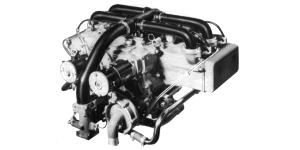 |
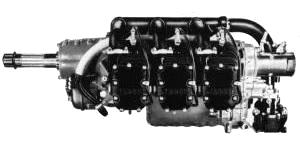 |
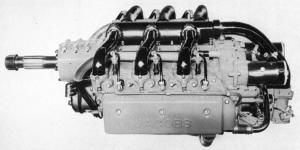 |
| Jacobs O-240A |
Jacobs O-240L |
Jacobs O-360A |
Jacobs O-360L |
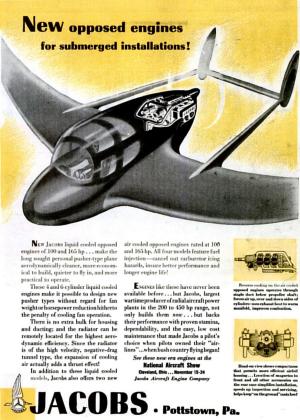 |
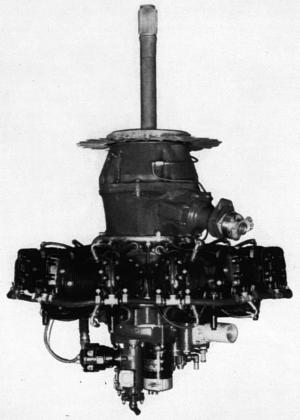 |
| Jacobs 1946 Advertisement |
Jacobs R-755HE |
Jacobs introduced a helicopter engine in 1953, the R-755HE. This engine featured an integral reduction gearbox with concentric rotor drive and SU direct fuel injection. Rated at 370 hp and 2,650 rpm for takeoff and 360 hp, 2,500 rpm normal, it weighed 520 lb, for a specific output of 0.71 hp/lb. The R-755HE apparently never received a type certificate.
The Cessna 195
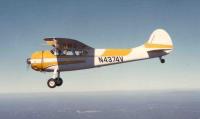 |
 |
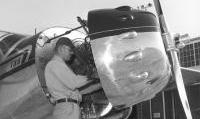 |
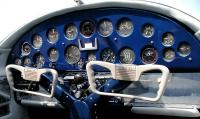 |
| Robert Brown’s Cessna 195A |
Cessna 195 |
Engine Swings for Access |
Instrument Panel |
The R-755A was developed by, among other things, improving the intake manifold efficiency and increasing compression ratio to 6:1, which required 80 octane fuel. Cessna selected it for use in its Model 195, and advertised the airplane as having "airline-type engines". In 1950, Cessna decided to stop buying new R-755As due to increasing cost. Buyers were allowed to supply their own R-755-9(L-4MB) engines to be installed by Cessna on what was designated Cessna 195A. Page Aircraft had hundreds of surplus military overhauled engines, which they would run on a test stand and then ship to Cessna when requested by a customer. Jacobs didn't like losing business and had a large number of runout R-755-9s stored at its factory. Jacobs decided to chrome the cylinder barrels and install the latest high compression pistons from the R-755A to create what was called the R-755B, rated 275hp. That decreased the price enough to make Cessna happy and thus began the Cessna 195B with the R-755B engine.
Jacobs’s Decline
During the 1940s and -50s, Jacobs was one of many companies building APUs for the Boeing B-47, along with performing other sub-contracting work. Jacobs Aircraft Engine Company continued making radial engines into the mid-1950s for Cessna 195s and their military counterparts, and for agricultural aircraft. Cessna stopped production of the 195 in 1955 and ag operators developed a preference for the more powerful Pratt & Whitney R-985 and R-1340. It is reported that Jacobs had a museum with examples of all its engines until about 1960. Operations were eventually moved to a small building at the Pottstown Limerick Airport. Jacobs built up some new R-755A2Ms for the Grumman AgCat in 1963; otherwise their business had been reduced to just overhauling engines. Prior to WWII, Jacobs built an estimated 1,500 engines. During the war it produced 20,300 Jacobs engines(R-755, R-830, R-915) and 11,614 P&W engines (R-983 and R-1340) under license. The P&W engines were built in a government-owned plant near Pottstown, which was purchased by Firestone Tire after the war. Jacobs was the last company in the U.S. to build R-985s. Postwar engine production is estimated at about 1,000.
After the Jacobs Aircraft Engine Company
Clarence E. Page was an Oklahoma aviation legend who served with the U.S. Army Air Service during WWI, barnstormed part-time between the wars, and operated flight schools that trained over 8,500 aviation cadets during WWII. After the war, Page created a number of corporations that were involved in aircraft sales, maintenance, engine overhauling and engine component overhauling. Page, who was active in the support of agricultural aircraft, acquired most of Jacobs Aircraft Engines' type certificates when Jacobs Aircraft Engine Company ceased production and was dissolved on 22 Jul 1957.
New engines built by Page's company were called Jacobs-Page. Jacobs-Page also developed a new engine, a refined R-755 with a turbosupercharger, known as the R-755S. This engine used an Airesearch TE 06 turbosupercharger with the entire exhaust stream always passing through the turbine; no waste gate was employed. Manifold pressure was limited by a relief valve installed between the compressor and the carburetor. Excess air was vented overboard by this valve so that the manifold pressure did not exceed a maximum value. The turbosupercharger was lubricated by engine pressure oil obtained from a fitting on the rear crankcase. This oil drained by gravity back to the engine sump after passing through all air-oil separator.
On 12 Dec 1972, Page created a new company called Page Industries of Oklahoma, which absorbed all of Page's other companies and became the type certificate holder for Jacobs engines. These type certificates were sold to Jacobs Service Company, an Arizona company owned by Bill Goodman, in the late 1970s or early 1980s.
Goldman, who owned a large gear manufacturing concern, bought the Jacobs business from Page and moved everything to Payson, Arizona. He then bought Carl Baker's Jacobs inventory, which was the largest collection of new parts, and most of Paul Gingrich's inventory. He hired Jim McCracken as shop foreman and Jacobs Service Company got a good reputation as a Jacobs overhaul shop under his supervision. McCracken eventually left and wound up helping Steve Curry at Radial Engines Ltd. Without McCracken, quality began to suffer. Goldman eventually shut down and sold the business to a Mississippi company, Air Repair, Inc., on 2 Jan 2002. Goldman's legacy is that he put up the money to bring all the largest Jacobs parts inventories together. The only large inventory that he didn't get was the Fresno Airmotive inventory, which was purchased by Robert Weber.
Air Repair, under the direction of Pete Jones, embarked on a Jacobs engine improvement and modernization program in early 2003. In addition to enhancing performance by converting 220 hp engines into ones producing 275hp, the program incorporated modern materials, improved oil consumption, and improved oil drainage. Certification of the changes involved a successful 150 hr endurance run with 50 hours at 300 hp, 500°F cylinder head temperature, 300°F cylinder barrel temperature, and 210°F oil temperature.
Specific engine improvements included:
- A two-piece oil control ring whose tension is derived from a spring, a more modern design that significantly reduces oil consumption.
- Elimination of oil control ring vent holes in pistons 4 and 5, reducing oil seepage into lower cylinders and resulting in cleaner starts.
- Substitution of modern silicone gasket material for the original asbestos-impregnated gaskets, silicon o-rings for cylinder base seals, and incorporation of silicon o-rings in the tappet guides and propeller governor oil pressure fitting. A drain fitting was installed in the cylinder 4 intake pipe to drain pooled oil and prevent hydraulic lock. Modern garlock-type magneto and generation drive seals were incorporated.
- Replacement of bronze exhaust valve seats with ones made from modern high-temperature steel alloy. These seats, along with valve rotators, improve exhaust valve reliability. Intake and exhaust valve guides now use modern alloys and accommodate positive intake valve stem seals, giving dramatically cleaner starts and eliminating oil leakage into lower cylinders.
- Modification of the accessory drive and oil pump housings to provide clearance for a Jasco alternator.
- Changing the crankshaft balance weight to reduce engine vibration.
- Reducing master rod bearing clearance to decrease the oil flow and temperature.
- Substitution of modern MIL-6000C hose and modern hose clamps.
- Introducing Champion REM37BY protruding-electrode spark plugs, which are less prone to fouling, better starting, and give a more efficient fuel burn.
- Incorporating more modern and reliable nuts and locking means.
- Applied high performance coatings to internal components; piston crowns, valve faces and cylinder head interiors were coated with a thermal barrier to restrict combustion heat transfer into the parts. Other parts, such as valve stems and cam rollers, were coated with a dry film lubricant to reduce friction and wear. Several parts were coated with a thermal dispersant to allow the oil to more efficiently cool the parts and to shed oil more quickly for better scavenging on shutdown.
These modern Jacobs engines continue used in Cessna 195s, Boeing Stearmans, and various Wacos, among others. More information is available from the Air Repair website.
Robert Brown remembers,
"
My father bought his first Cessna 195 in 1968 and became very active flying it after 1971. In those days many former Jacobs employees were still working. Carl Baker was a former aircraft broker who had gone into buying surplus engine parts after WWII and had the largest stocks of Jacobs and Franklin parts, selling surplus parts to the factories. He had hired Fred Lillich, a former Jacobs employee, to run his overhaul shop. Paul Gingrich was in Spring City, Pennsylvania overhauling engines. He had bought a stock of Jacobs parts from Chris Stoltzfus and also would get some parts from someone near Pottstown who had bought a large amount of war contract termination parts. He had a photo of Albert Jacobs and I remember him referring to ‘Mr. Berger.’ He also had a newspaper clipping about someone who built a go-kart with a B-47 APU engine. Back then it would have been possible to get a lot of info of Jacobs history but I just listened to what people said and didn't try to quiz them. Today if you ‘Google’ Jacobs, you'll find a lot of obituaries from the past ten years listing Jacobs as a former employer of the deceased. During the time that Page was closed and before Goldman bought the business, obtaining quality overhauls for Jacobs engines looked questionable. My father bought tools to develop an overhaul capability but that never became necessary. You really need the surplus parts to make overhauls practical. Pete Jones is putting lots of new parts into engines rather than expend labor on the old parts. They go into drums and someday, somebody will be pulling them out after the new parts are exhausted."
References
Aerosphere 1939
FAA Type Certificate Data Sheets E-121, E-156, E-195, E1sw and E-237
Aircraft Engines of the World, 1947, 1953, 1955. Paul H. Wilkinson.
Model Designations of U.S.A.F. Aircraft Engines
National Archives Record Group 342, RD2629, Jacobs R-1530-0 Engine 1943
Pottstown Mercury Newspaper, 21 Sep 1960.
Telephone Conversation between Pete Jones of Air Repair, Inc. and the Author, 8 May 2018.
Acknowledgements
Many thanks to Paul Christainsen, who located and forwarded the R-1530 file from the U.S. National Archives, and to Michael Smith, who provided material from which the article was compiled.
Thanks also to Pete Jones of Air Repair, Inc.























